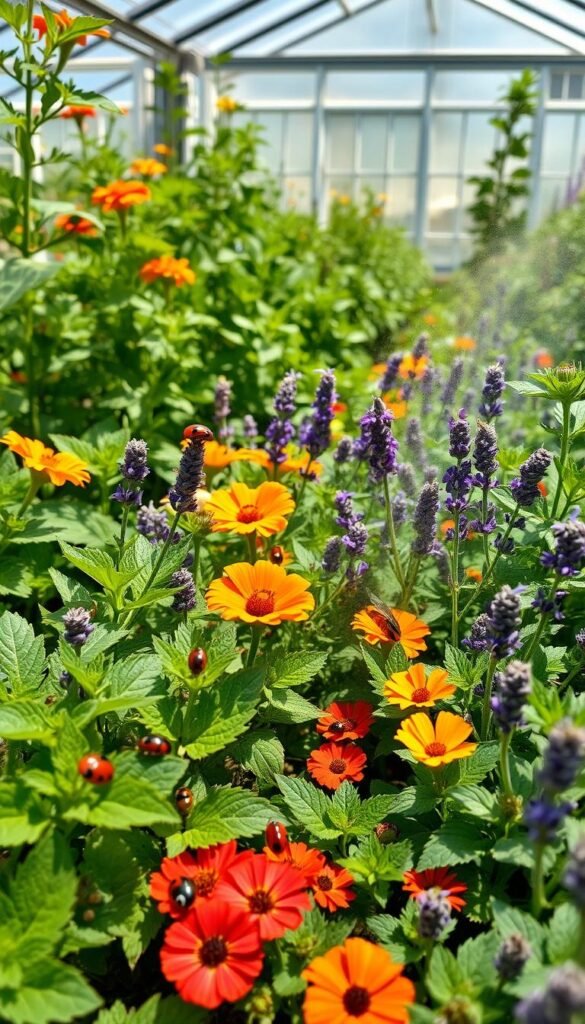Growing herbs and veggies without soil might sound futuristic, but hydroponic systems make it possible. These setups use nutrient-rich water to nourish plants, offering faster growth and higher yields. Plus, you avoid soil-borne diseases. But even in this clean environment, tiny invaders can still cause trouble.
Why focus on natural solutions? Chemicals might harm your delicate system or affect the quality of your harvest. Unwanted visitors like aphids or spider mites can quickly damage leaves and stunt growth. Spotting early signs—like yellowing foliage or sticky residue—helps you act fast.
Though hydroponics reduces risks, it doesn’t make your garden pest-proof. Whiteflies, for example, thrive in warm conditions and multiply rapidly. Simple tools like sticky traps can catch flying insects before they spread. But prevention starts with knowing what to look for.
Ready to protect your greens? The next sections will walk you through eco-friendly strategies. Learn how to disrupt pest life cycles and keep your setup thriving—all without harsh chemicals. Because a healthy garden begins with smart habits.
Understanding Hydroponic Pest Management
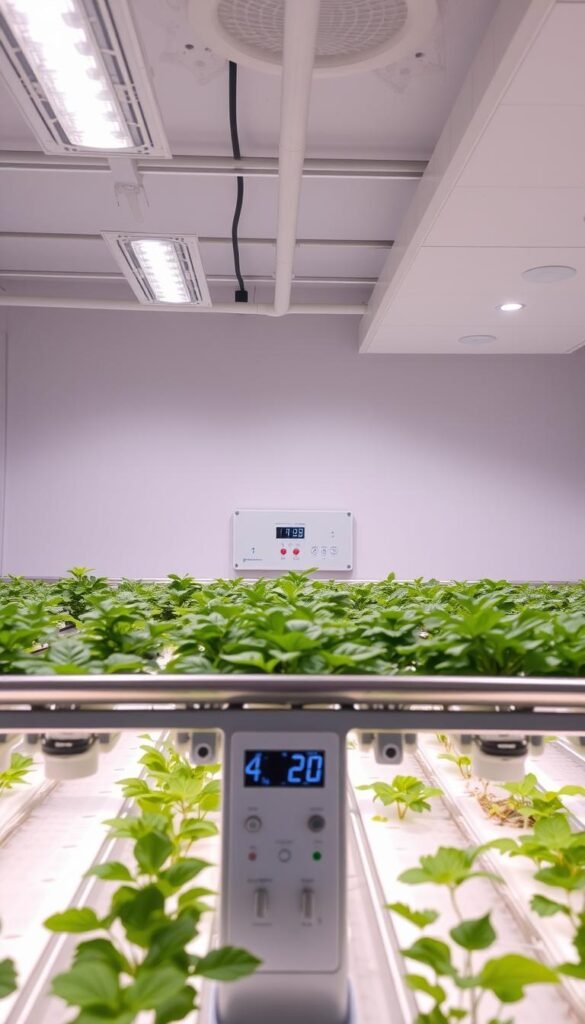
Spotting tiny invaders early makes all the difference in maintaining a thriving setup. Whether you’re growing leafy greens or herbs, vigilance keeps your plants strong and productive. Let’s explore how to stay ahead of problems before they escalate.
Recognizing Early Signs of Infestation
Check new growth and leaf undersides daily—these are hotspots for pests. Yellowing or curling foliage often signals trouble. Sticky residue or tiny webs? Spider mites or aphids might be lurking.
A magnifying glass helps spot eggs or nymphs hiding in plain sight. Discolored roots or slow growth? Your water-based system could be spreading diseases. Don’t wait—act fast to stop an infestation from spreading.
Benefits of a Sterile Growing Environment
Clean equipment is non-negotiable. Sterilize tools and trays between uses to block pathogens. Replace growing media regularly, especially after harvesting.
Why does this matter? Unfiltered water or reused nutrients invite mold and bacteria. For deeper insights, explore our guide on troubleshooting common hydroponic garden problems. Simple habits like wiping spills and trimming dead leaves keep your garden resilient.
Stay consistent. A tidy space means healthier roots and fewer surprises.
Implementing Common Hydroponic Pests and How to Prevent Them Naturally
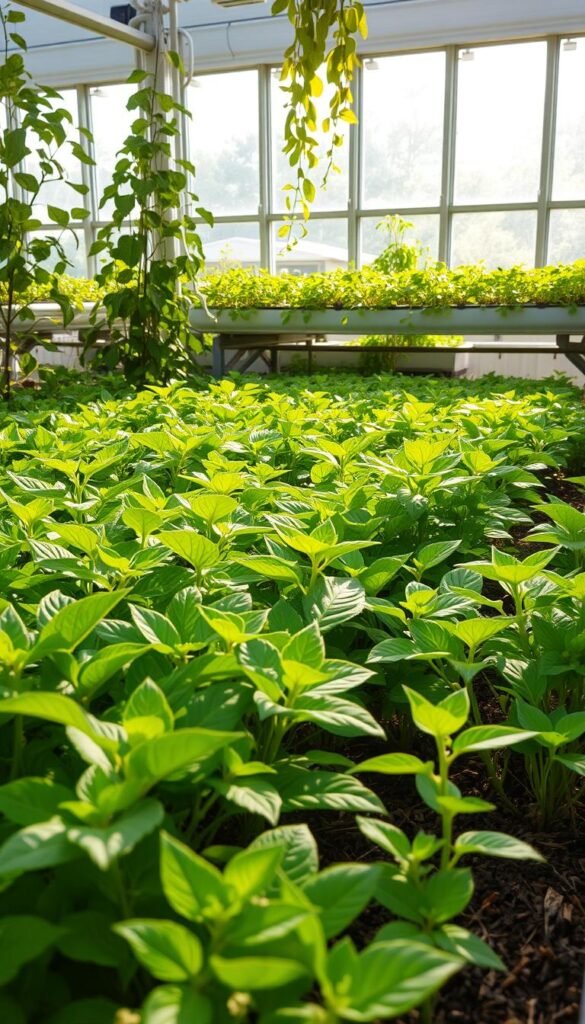
Effective pest management begins with prevention, not reaction. By creating an environment that’s hostile to invaders but safe for plants, you’ll save time and protect your harvest. Simple, consistent habits can stop problems before they start.
Harness Nature’s Solutions
Neem oil is a gardener’s best friend. Mix it with water and spray leaves weekly to deter mites and disrupt egg cycles. For quick fixes, a mild soap solution removes pests without harming roots.
Always inspect new plants. Quarantine them for a few days to avoid introducing hidden threats. Wipe down trays and tools with hydrogen peroxide—this stops fungus spores from spreading.
Master Your Growing Conditions
Keep humidity below 60% to discourage mold and pests. Use fans for airflow, and monitor temperatures—most bugs thrive above 75°F. Clean reservoirs monthly to prevent slime buildup.
Replace nutrient solutions regularly. Stagnant water attracts gnats and breeds bacteria. Pair these steps with yellow sticky traps for early detection. Your plants will reward you with vigorous growth and fewer surprises.
Identifying Key Pests: Aphids, Whiteflies, Spider Mites, and Thrips
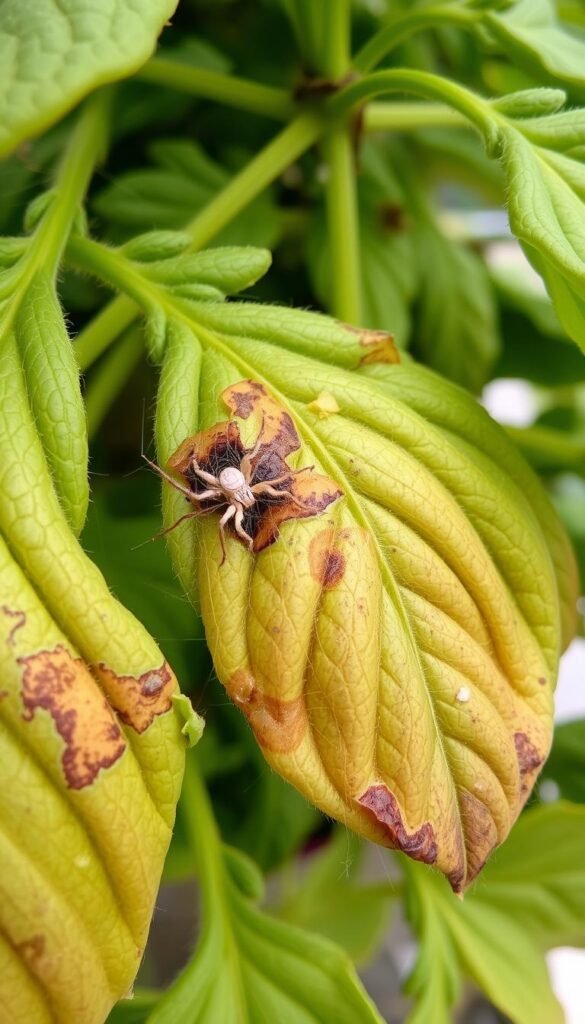
Even the cleanest setups can host unwanted visitors. Tiny pests often slip in unnoticed, but their damage becomes obvious quickly. Let’s break down what to watch for and how to catch problems early.
Spotting Visible Damage on Plants
Aphids cluster on stems and undersides of leaves, leaving sticky honeydew. Look for pale green or black specks no bigger than a pinhead. Whiteflies flutter when disturbed, causing yellow speckles as they drain sap.
Spider mites create fine webs between leaves. Their feeding causes stippling—tiny white dots that merge into faded patches. Thrips scrape surfaces, leaving silvery streaks and deformed growth.
Make sure to inspect daily. Use a magnifying glass to spot eggs or nymphs hiding near veins. Yellow sticky traps placed near foliage catch flying adults before they multiply. Wipe leaves gently with a damp cloth to check for residue or tiny crawlers.
Control outbreaks by isolating affected plants immediately. Trim heavily damaged areas to redirect energy to healthy growth. Pair traps with weekly sprays of diluted neem oil for ongoing protection. Healthy roots and balanced nutrients help your greens resist invaders naturally.
Managing Fungal Issues: Powdery Mildew, Gray Mold, and Root Rot

Fungi thrive where plants flourish, and water-based systems are no exception. These silent invaders attack leaves stems and roots, often going unnoticed until damage becomes severe. Quick action keeps your setup productive and safe.
Spot Trouble Before It Spreads
Powdery mildew looks like flour dusted on foliage. Gray mold causes brown spots and drooping stems. Root rot turns roots slimy and dark—a sign of poor oxygenation. Check your grow room daily for these clues.
Remove infected plants immediately to protect others. Apply food-grade fungicides to unaffected areas. Improve air circulation with fans—stagnant air invites trouble.
Control Your Environment
Keep humidity between 40-60% using dehumidifiers. Temperatures below 70°F slow fungal growth. Wipe condensation from surfaces to prevent mold-friendly moisture.
| Fungus | Signs | Immediate Action |
|---|---|---|
| Powdery Mildew | White powder on leaves | Prune affected areas |
| Gray Mold | Brown, mushy stems | Increase airflow |
| Root Rot | Black, slimy roots | Replace water & add air stones |
Clean tools and trays weekly using proper sterilization methods. This stops spores from hopping between plants. Healthy roots start with a balanced system—don’t let fungi crash the party.
Practical Strategies for Natural Pest Control
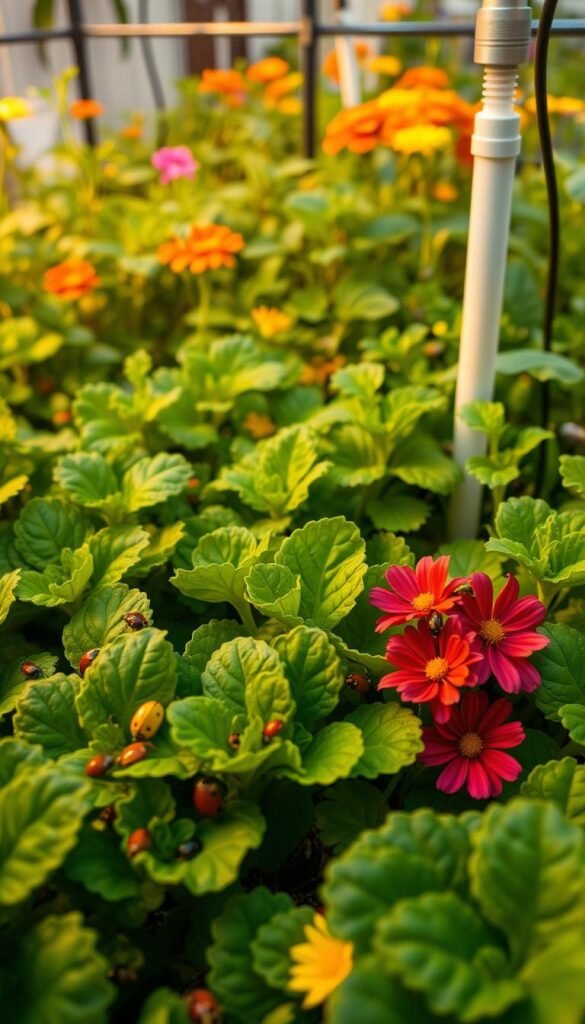
Keeping your garden pest-free doesn’t require harsh chemicals—just smart, natural tactics. Combine simple tools with biological allies to create layered defenses. Consistency matters most when disrupting pest life cycles.
Using Sticky Traps and Insecticidal Soaps
Bright yellow or blue sticky cards act as early warning systems. Place them near stems and foliage to catch flying adults like whiteflies. Replace weekly to maintain effectiveness.
Mix insecticidal soap with neem oil for a gentle spray. Target leaf undersides where aphids hide. Apply every 5-7 days until pests disappear. Always test sprays on a few leaves first.
Incorporating Beneficial Predators
Release ladybugs or lacewing larvae near infested plants. These hunters devour aphids and mites without harming your greens. Keep humidity moderate to keep them active.
Check for mildew weekly by inspecting older leaves. Trim affected areas and boost airflow. For persistent issues, apply a baking soda solution (1 tsp per quart of water) to stop spore spread.
Pro tips:
- Clean root zones monthly to prevent algae buildup
- Quarantine new plants for 48 hours before introducing them
- Use cinnamon powder in growing media to deter fungus
Essential Tools and Maintenance Tips for Hydroponic Success
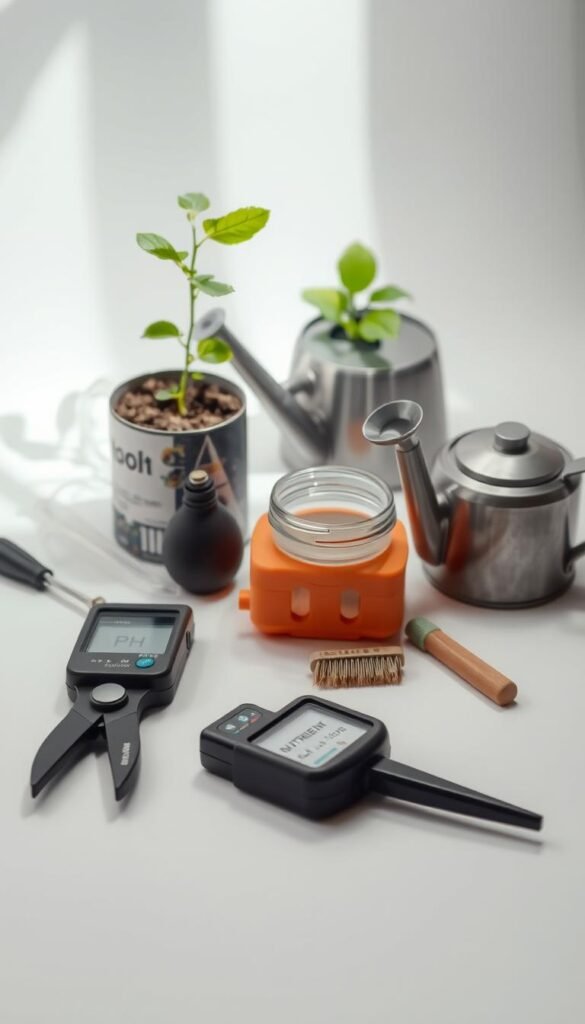
Your hydroponic system’s performance hinges on daily care and the right gear. Like a well-oiled machine, consistent upkeep prevents minor issues from becoming major headaches. Let’s explore how to keep everything running smoothly.
Optimizing Water Aeration and Nutrient Flow
Healthy roots need oxygen as much as nutrients. Air stones and water pumps create bubbles that boost dissolved oxygen levels. This prevents root rot and helps plants absorb minerals efficiently.
Check your air pump’s output weekly. Weak airflow? Clean or replace clogged air stones. Nutrient solutions should circulate fully—stagnant pockets breed algae and attract pests.
| Tool | Purpose | Maintenance Tip |
|---|---|---|
| Air Pump | Boosts oxygen levels | Clean filters monthly |
| pH Meter | Monitors acidity | Calibrate every 2 weeks |
| EC Tester | Measures nutrient strength | Rinse probe after each use |
| Net Pots | Holds plants in place | Soak in hydrogen peroxide weekly |
Inspect leaves every 3 days. Yellow edges or brown spots often signal nutrient imbalances. Adjust your solution’s pH (5.5-6.5 ideal) before damage spreads. Wipe down reservoirs with vinegar to remove mineral buildup.
New to hydroponics? Our beginner’s guide breaks down equipment basics. Remember: clean tools and timely adjustments matter more than fancy gadgets. A little effort today means lush growth tomorrow.
Finalizing Your Hydroponic Pest Prevention Strategy
A thriving hydroponic garden starts with smart prevention, not just quick fixes. Combine daily checks with natural solutions to build a fortress against invaders. Remember: catching issues early saves your plants from severe pests diseases.
Revisit your grow room setup monthly. Ensure proper airflow and humidity control—these simple tweaks deter fungus gnats and mold. Wipe surfaces regularly and keep tools sterilized to break pest life cycles.
Stick with earth-friendly treatments like neem oil sprays and predator insects. They tackle infestations without harming your system’s balance. Pair these with yellow traps to monitor flying nuisances silently.
Stay ahead with this quick checklist:
- Inspect leaf undersides every 3 days
- Test water pH weekly to prevent root rot
- Quarantine new plants for 48 hours
Your efforts today determine tomorrow’s harvest. By blending vigilance with nature’s tools, you’ll keep your greens growing strong—no chemicals required.

